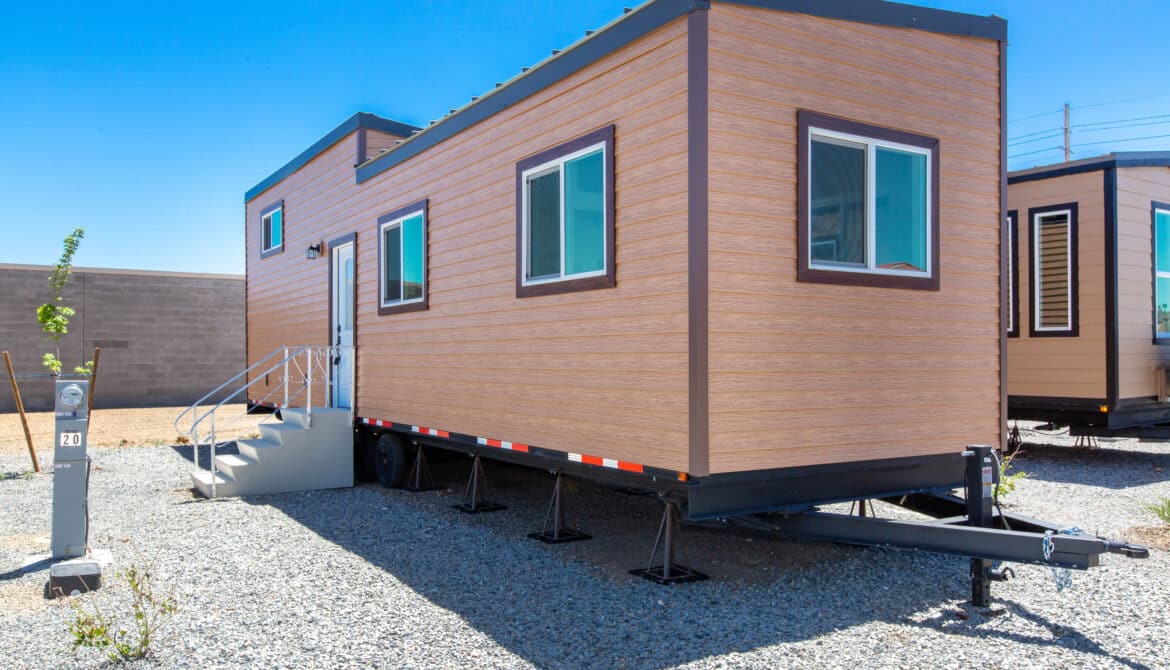Table of Contents
Tiny houses have become a popular trend in recent years, and for good reason. They offer an alternative to traditional housing that is both cost-effective and environmentally friendly. Tiny houses are often defined as dwellings that are less than 500 square feet in size, although there is no universal definition of what constitutes a tiny house.
For many people, the idea of living in a tiny house seems daunting or even impossible. But with some creativity and careful planning, it can be done. Living in a tiny house has its advantages and disadvantages, so it’s important to weigh all the pros and cons before making the decision to downsize.
In this article, we will explore what a tiny house is, common sizes of tiny houses, the benefits of living in one, and the challenges associated with it. We hope that by the end of this article you will have a better understanding of what it takes to live in a tiny house and whether or not it’s right for you.
What is a Tiny House?
A tiny house is a small, self-contained dwelling that is typically built on wheels and designed to be mobile. The size of a tiny house can vary, but they are generally between 100 and 400 square feet in size. They are often constructed using traditional building materials such as wood, metal, and even recycled materials. Tiny houses are usually built according to local building codes, though some may be exempt from certain regulations due to their small size.
Tiny homes can provide an affordable housing option for those who do not have the resources or space for a larger home. They are also popular among those looking for an alternative lifestyle that is more sustainable and less expensive than traditional housing options. Additionally, many people find that living in a tiny house allows them to live closer to nature and enjoy more freedom than traditional housing options provide.
Common Sizes of Tiny Houses
The most common sizes of tiny houses range from 100 to 400 square feet, though some may be smaller or larger depending on the individual’s needs and preferences. Generally speaking, the smaller the house, the easier it is to move around and transport from one location to another. Some of the popular sizes include:
• 100-150 square feet: This size is perfect for those looking for an efficient living space with minimal amenities. It typically includes one room with a kitchenette, bathroom, and sleeping area all combined into one space.
• 150-200 square feet: This size provides enough space for two rooms – typically a bedroom/sleeping area and a kitchen/living area – plus some additional storage space.
• 200-300 square feet: This size allows for two separate rooms plus some additional storage space, making it ideal for couples or small families who need more room than what’s offered in smaller models.
• 300-400+ square feet: This size provides enough room for multiple bedrooms, bathrooms, kitchens, living areas, etc., making it suitable for larger families or those who need extra room for guests or hobbies.
Common Sizes of Tiny Houses
Tiny houses come in a variety of sizes, but the most common sizes are 8×20, 10×20, 12×24, and 14×28. The size you choose depends on your lifestyle and needs.
8×20 Tiny House
The 8×20 tiny house is one of the smallest options available. It offers an efficient living space with enough room for two people to sleep comfortably. This size is great for those who want to travel often or live in a more minimalist lifestyle.
10×20 Tiny House
The 10×20 tiny house is slightly larger than the 8×20 option and offers more living space for two people. This size is perfect for those who need more storage or want to create a small workspace.
12×24 Tiny House
The 12×24 tiny house is a great option for those looking for more living space while still keeping their home small and efficient. This size allows for up to four people to sleep comfortably and offers plenty of storage and workspace options.
14×28 Tiny House
The 14×28 tiny house is the largest option available for those wanting to live in a tiny home. This size can comfortably accommodate up to six people and provides plenty of room for storage and activities such as yoga or crafting. It’s also ideal for those who want to host guests or have pets that need extra space.
No matter which size you choose, it’s important to consider how much living space you’ll need before making your decision. If you’re unsure about which size would be best for your lifestyle, it may be helpful to talk with a tiny house expert who can help guide you through the process.
|
Size
|
Capacity
|
Features
|
|
8×20
|
2 people
|
Efficient living space, great for travel and minimalist lifestyle
|
|
10×20
|
2 people
|
More storage and workspace options available
|
|
12×24
|
4 people
|
Plenty of storage and workspace options available, ideal for hosting guests or having pets that need extra space.
|
|
14×28
|
6 people
|
Room for activities such as yoga or crafting, ideal for hosting guests or having pets that need extra space.
|
Benefits of Living in a Tiny House
Living in a tiny house has become increasingly popular over the last decade, with more and more people opting for this lifestyle. The tiny house movement is based on the idea that living simply and sustainably can be beneficial to both individuals and the environment. There are many advantages to living in a tiny house, from financial savings to environmental benefits.

Financial Savings
One of the most obvious benefits of living in a tiny house is the potential to save money. Tiny houses are much cheaper than traditional homes, as they require much less material and labor to build. Additionally, because they are smaller, they use fewer resources such as electricity and water than larger homes. This means that homeowners can significantly reduce their utility bills. Furthermore, since tiny houses are often built on trailers or foundations that do not need permits or inspections, there are fewer upfront costs associated with building them.
Environmental Benefits
In addition to financial savings, living in a tiny house also has environmental benefits. Since they require fewer materials to build and maintain, there is less strain on natural resources such as trees and other materials used for construction. Additionally, since tiny houses use fewer resources such as electricity and water, they have a lower carbon footprint than traditional homes. This makes them an attractive option for those looking to reduce their environmental impact.
Flexibility
Another benefit of living in a tiny house is the flexibility it provides. Since most tiny houses are built on wheels or foundations that don’t require permits or inspections, homeowners can move their home wherever they want without having to worry about zoning laws or other regulations that might apply to traditional homes. This makes it easy for people who want to travel frequently or take extended vacations without having to worry about finding somewhere suitable to stay while away from home.
Simplicity
Finally, living in a tiny house can be beneficial for those who want a simpler lifestyle with fewer possessions and clutter. Because of their small size, it’s easier for homeowners to keep their space organized and tidy without having too much stuff taking up space. This allows them to focus on what matters most instead of being overwhelmed by clutter and possessions they no longer need or use.
Overall, living in a tiny house offers many advantages from financial savings to environmental benefits and simplicity of life. For those looking for an affordable yet sustainable way of life, it may be worth considering this option as an alternative housing option.
Living in a tiny house offers financial savings, environmental benefits, flexibility and simplicity. Cheaper to build, lower utility bills, lower carbon footprint, mobility, less clutter and possessions.
Challenges of Living in a Tiny House
Living in a tiny house can be a great way to save on costs and live more sustainably, however there are many challenges that come with it. The most obvious challenge is the lack of space. Despite being creative with storage solutions, living in a tiny house means having to sacrifice some of your belongings. This can be difficult for those who have accumulated lots of possessions over the years and may not want to part with them.
Another challenge is the lack of privacy. Tiny houses are often built on wheels, which means they can be moved from place to place. This means that you may not always have access to private land or a backyard where you can relax in peace and quiet. Additionally, due to their size, tiny houses are usually quite close to one another, meaning that there may be less soundproofing between neighbours than there would be in larger homes.
Tiny houses also tend to lack amenities such as running water and electricity, which can make them difficult to live in during colder months. If you’re living off-grid, then you’ll need to be prepared for dealing with limited resources like fuel for heating and cooking. Additionally, depending on the laws in your area, it may be difficult or even illegal to build a tiny house without meeting certain requirements such as building codes and zoning regulations.
Finally, if you decide to move into a tiny house after already owning a larger one, it may take some time getting used to the lifestyle change. It’s important to remember that living in a tiny house isn’t for everyone and it’s important to think carefully before making such a big decision.
Space Limitations
The primary challenge with living in a tiny house is the lack of space available for living and storage purposes. Due to their small size, it can be difficult or impossible for people who own larger items such as furniture or appliances to fit them into their home. Additionally, due to their compact nature, it’s often necessary for occupants of tiny houses to get creative when it comes finding storage solutions or ways of utilizing every inch of space available inside their home.
Amenities
Tiny houses typically lack amenities such as running water and electricity which can make them difficult or impossible for people who require these services regularly. Additionally, depending on the laws in your area, it may be difficult or even illegal for people who wish to build their own tiny house without meeting certain requirements such as building codes and zoning regulations.
Conclusion
Living in a tiny house can be a great way to reduce your environmental impact, simplify your lifestyle, and save money. However, it is important to consider the challenges of living in a tiny house before making the decision to downsize. The size of a tiny house can be an issue as it limits the amount of space available for storage and living. Additionally, there are certain zoning regulations that may limit where you can build your tiny house.
Overall, living in a tiny house is an appealing option for many people looking to live more simply and sustainably. It’s important to weigh the benefits and challenges before deciding if this is the right choice for you.


